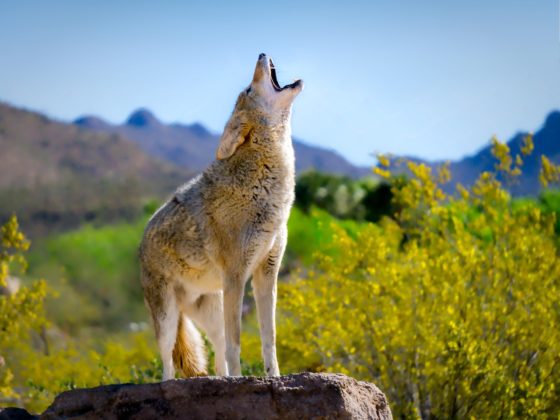1. Getting to know the desert’s furry, scaly, and feathered denizens
Arizona just wouldn’t be Arizona without visions of roadrunners, coyotes, and rattlesnakes. This trio of desert life is just the beginning of the area’s biodiversity, as you’ll soon find out at the Arizona-Sonoran Desert Museum.
Located on the mountainous edge of Tucson, this museum is like a combination of a world-class botanical garden and a zoo. From fall through spring, you can catch a birds-of-prey free-flight demonstration, where you’ll practically feel the brush of feathers as raptors swoop above you from saguaro to saguaro. Mountain lions, parrots, bighorn sheep, javelinas, and, of course, lizards and snakes — visit them all in well-thought-out habitats. See the miniature nests in the hummingbird aviary and pet stingrays in a saltwater pool (remember, the Sea of Cortez is just a few hours’ drive away). Lush? Desert? So close together? Absolutely.
2. Wine tasting around the state
Parts of Arizona have soil and climate conditions similar to those of Bordeaux and Burgundy in France. Now that you’re in the know, come and check out the vineyards.
North of Phoenix, the Verde Valley grows about a hundred grape varieties near the towns of Jerome, Cottonwood, and Camp Verde. South of Tucson, the high desert grasslands around Sonoita and Elgin have been producing wine for decades in a rolling landscape home to pronghorn antelope. And in the state’s far southeast, the Willcox area’s soil and climate have been compared to the Rhône valley and parts of Argentina. Check out this guide to Arizona’s wine trails for more ideas of where to go.
3. Skiing above the saguaros
Skiing in Arizona? Yep, both down south and up north. High above Tucson in the Santa Catalina Mountains, Mt. Lemmon Ski Valley is home to the southernmost ski runs in the U.S., and after a day among the Douglas firs, it’s an easy drive down to a poolside, palm-framed view of those same mountains.
And just outside one of the snowiest cities in the country, Flagstaff, is Arizona Snowbowl, where more than 700 acres of slopes and runs sit 9,500 feet above sea level on the volcanic San Francisco Peaks — the highest points in the state.
4. Wandering the red rocks of Sedona
The luminous country around Sedona draws hikers and seekers from around the world. Some come looking for an “energy vortex”; others are content to browse the galleries in town. For a truly unique adventure, though, the red rocks steal the show. Mesas, buttes, and pinnacles rise from junipers and cottonwood-and-sycamore-lined creeks, defining the horizon with their varieties of form and color.
Outside magazine says, “If you thought that Moab has a corner on red-rock desert riding, think again.” The mountain biking here is some of the best and most varied in the States. In winter, when the the trails can get icy, you might prefer a short hike like Boynton Canyon Vista, which leads to a grand saddle between stunning rock spires.
5. Gazing at the stars in the clarity of the desert
Astronomers around the world recognize Arizona as a premier destination for studying the skies — the International Dark-Sky Association has its worldwide headquarters right here in Tucson for good reason. Venture up to Kitt Peak National Observatory for public night programs, or reserve an overnight private telescope viewing package, which will include meals and a place for the night — not that you’ll want to do much sleeping when you have access to this high-powered scope, and the wide-open night sky waiting for you.
Up in Flagstaff, Lowell Observatory is one of the oldest in the country — it’s where Pluto was discovered back in the 1930s. For less-high-tech sky-watchers, there’s no shortage of quiet mountainsides and desert stretches where you can just park, put a blanket on the hood, and stare up into the marvels of space. The clarity of the air and the dark skies of Arizona provide, literally, out-of-this-world viewing conditions.
6. Tasting the origins of the region’s flavors
“Farm-to-table” and “locally sourced” have become guiding mottos for today’s food-minded travelers, and Arizona provides plenty of tastes-of-place. From Mexican-U.S. border cuisine (this is the birthplace of that beautiful deep-fried burrito, the chimichanga) to fusion tastes (want some kimchi on your taco?) and pick-your-own orchards (yes, there are orchards in this not-entirely-desert state), you won’t go hungry.
The buzzing city of Tucson has recently been named by UNESCO as the first World City of Gastronomy in the U.S. Its agricultural history goes back 4,000 years, and the farmers market scene is as vibrant as you’d expect, with heirloom crops making a comeback.
Try Sonoran wheat bread leavened with wild yeast at Barrio Bread, and mesquite-smoked single malt Del Bac whiskey from Hamilton Distillers. Buy local cactus fruit syrups, visit one of the oldest Mexican restaurants in the country, and head to a hotdoguero vendor for a bacon-wrapped Sonoran hot dog dressed with a feast of taco toppings and, often, a side of freshly roasted chili pepper.
7. Encountering ruins, petroglyphs, and history with a Navajo guide in Canyon de Chelly
Sandstone cliffs a thousand feet high, pre-Columbian petroglyphs, ancient cliff dwellings, groves of cottonwoods, horses roaming free beneath fiery red spires — it sounds like a dreamscape, but it all comes together in reality in Canyon De Chelly National Monument.
It’s one of the longest continuously inhabited places in North America, as generations of Navajo have called this stunning network of gorges home, and before them Hopi, Pueblo, and others, going back nearly 5,000 years. In more recent centuries, encounters with newly arrived Spaniards and U.S. soldiers led by Colonel Kit Carson have resulted in not-always-peaceful endings, but these compelling canyons are tranquil today. To access the deeper reaches of the monument’s 83,840 acres, join a tour with a ranger or Navajo guide.
8. Restoring your body and soul at a world-class spa
At Sanctuary Camelback Mountain Resort in Scottsdale, there’s a Zen meditation garden, reiki, and medicinal herb massages. In Sedona, the beautifully designed Mii amo is known for its American Indian-inspired therapies. In the Santa Catalina Mountains around Tucson, you’ll find Canyon Ranch and Miraval Resort & Spa. The latter’s been ranked one of the world’s best spas in a wide variety of categories — best destination spa, best place for a girlfriends’ getaway, best spa for couples, the list goes on — by everyone from Travel + Leisure to SpaFinder and Condé Nast Traveler.
9. Exploring the Grand Canyon in the quiet of winter
No matter how many photos you’ve seen, nothing compares to being perched, in person, on the rim of the Grand Canyon and experiencing the immensity of the scene before you.
The summer crowds can be formidable, but from December through February you can drive your own vehicle west of Grand Canyon Village instead of lining up for a shuttle bus. Stop at any of the overlooks on your own schedule, hike a bit, and peer down into the play of shadows on the nearly two-billion-year-old rock and Colorado River, a vertical mile below you. Set your alarm and dress in layers for a sunrise from the edge, and watch, through your breath, the light pouring into these chasms of geological time.

